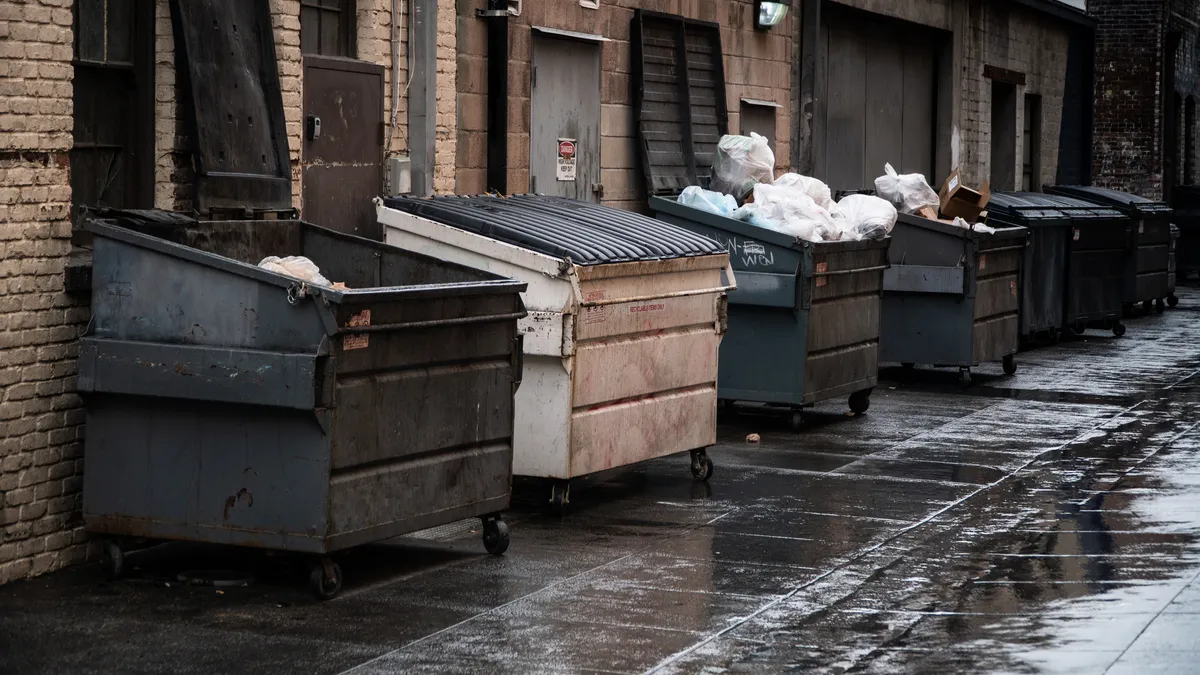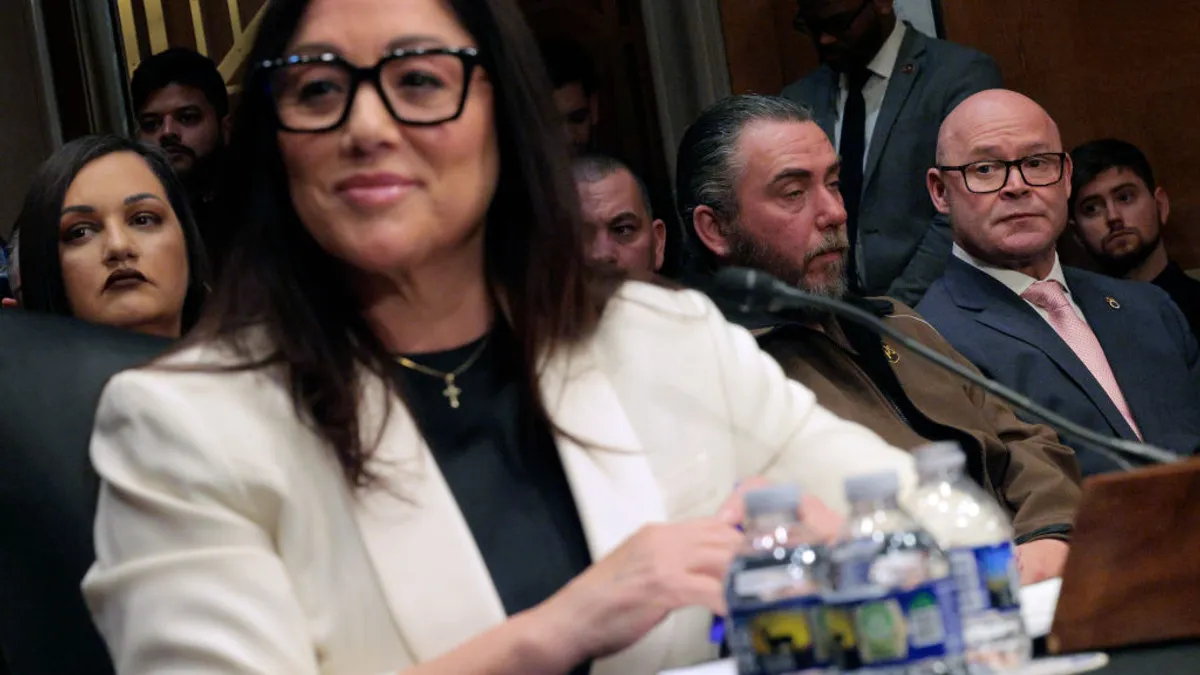Editor’s Note: Waste and recycling are inherently local issues in the United States, and we’re looking for new ways to highlight how these stories fit into broader trends. Send us your tips or feedback at waste.dive.editors@industrydive.com.
Cities explore how the American Rescue Plan can support waste initiatives
Since President Joe Biden last month signed into law the American Rescue Plan Act, the stimulus package with $350 billion for state and local governments, some municipalities have detailed how they plan to distribute the funds and others are still working through how the cash fits into their budgets.
Compared to last year’s federal relief known as CARES, the American Rescue Plan is considered to allow more flexible spending by states and localities. Municipalities have new ideas to use federal funds to enable everything from fare-free transit to a guaranteed basic income program.
Given that range, American Rescue Plan funds could also support some waste-related initiatives, particularly considering that many local solid waste departments struggled with staffing and other resources during the pandemic.
“We're already seeing this money begin to have an impact on solid waste operations,” said Conor Riffle, vice president of Smart Cities at waste software company Rubicon. From Rubicon’s perspective pitching municipalities on its own waste services digitization and optimization technologies, Riffle anecdotally said he’s seen municipalities accelerate procurement conversations because of the changing budget situation.
“They're able to actually get their priorities prioritized, whereas six months ago those priorities were on the chopping block.”
According to Riffle, American Rescue Plan funds are having an impact on waste operations in two broad ways. The first is that funds are being directly allocated to proactive waste-related initiatives. “Resilience is a word that a lot of municipalities have been kicking around for years and the pandemic really made clear just how important resiliency is for American cities.”
Secondly and more indirectly, if stimulus funds are put toward initiatives outside of waste, that can free up space in the existing budget.
Waste-related spending is being proposed in a variety of ways, according to local news reports from across the country.
For instance, San Jose, California, has explored whether it could avoid a trash collection rate increase by using stimulus funds as an offset.
Some cities are focused on cleaning up their public spaces, which comes after litter problems that proliferated during the pandemic. New Haven, Connecticut, is proposing spending a fraction of its ARP funds on neighborhood cleanups and new trash cans. Leaders in Santa Monica, California, pitched spending some money on sweeping and beach trash management. And more broadly, New York is launching a City Cleanup Corps to open up 10,000 jobs and work toward beautifying public spaces.
Yet another consideration is using the funds to award hazard or premium pay to essential workers who showed up throughout the pandemic which could include sanitation workers. That idea has been promulgated by policy groups and localities alike, and also came up in last year’s stimulus discussions.
D.C. establishes waste diversion baseline, charts path forward on zero waste goal
The D.C. Department of Public Works (DC DPW) this week released two reports meant to give a clearer picture of where the District stands as it aims to divert 80% of its waste by 2032. The efforts represent the first time D.C. has calculated its citywide diversion rate, versus previous renditions that isolated residential waste diversion, and the first citywide waste characterization study.
A solid waste diversion report assessing calendar year 2018 said citywide diversion was 16.11%, with the average daily waste generated per capita at 8.89 pounds, which DC DPW acknowledges is likely higher than that of a typical resident when factoring in the city’s high rate of tourists and commuters at the time. For residential waste specifically, roughly 25% was diverted in 2018, versus about 23% in fiscal year 2017. The report acknowledged it’s difficult for cities to carry out these types of assessments, making it challenging to compare D.C.’s metrics to peers’.
In 2018, the volume of waste being landfilled versus incinerated was about even at around 325,000 tons each. A little more than 164,000 tons were recycled. Just over 20,000 tons of waste were composted and about 33 tons were converted to biofuels.
Interim agency director Christine Davis said in a statement the reports’ findings allow the city “to more confidently plan.” Davis’ statement also heralded that “with the establishment of these performance metrics, the District is on track to become a leader in advancing progress towards zero waste.” But D.C. will have to see a fivefold increase in diversion the next decade over 2018 levels to meet its goal.
Making that all the more challenging is that D.C.’s zero waste omnibus law that took effect this year is yet to be fully funded, meaning key programs like expanding required organics diversion could be delayed or watered down. In the meantime, DPW is carrying out “foundational work so that we're poised to begin or implement the portions of the legislation once we've received funding,” Davis said earlier this year.
Another challenge to achieving the zero waste goal outlined in a separate desktop waste characterization study is that less than 30% of single-family waste could be diverted through existing recycling programs. “In the absence of a yard waste/food waste collection program, over 70 percent of the single-family stream has no convenient recovery options at this time,” the report states.
Broadly, that report aimed to project the District’s waste generation through 2038 and estimate the material breakdowns of mixed streams. Predicting population growth in the coming years — particularly a multifamily housing boom — D.C. expects its total MSW volumes to rise from 1.1 million tons in 2018 (which marked a 15% rise from 2013) to 1.4 million come 2038.
More updates from around the country:
-
New York announced plans to revive limited curbside organics service, and became a strategic partner of the Ellen MacArthur Foundation’s circular economy network this week, as local officials and advocates called out Mayor Bill de Blasio for a lack of progress on the city’s 2030 zero waste goal. In response to the surprise organics announcement, critics fired back by calling it one of his “most inherently inequitable proposals” yet and urging universal, mandatory organics service. (Waste Dive)
-
Los Angeles Mayor Eric Garcetti called for a citywide ban on polystyrene foam and “single-use foodware that cannot be reused or recycled” in his State of the City address this week. Days later the Los Angeles City Council passed an ordinance requiring disposable foodware only be available on request. This comes as a new report shows the city’s greenhouse gas emissions from waste increased 11% between 1990 and 2018.
-
Boston is partnering with Rehrig Pacific to to become the first city using new OceanCore recycling carts made from 40% post-consumer material, including 10% from “ocean bound plastic.” The carts are manufactured with a new process that involves an “outer skin” of virgin plastic for structural integrity. Boston aims to deploy 10,000 carts over the next two years.
-
Austin may reassess its own goal of zero waste by 2040 as part of a solid waste master plan update in the coming months. A report about progress toward a target of 75% by 2020 was delayed last year due to the pandemic. The most recent data estimated a 42% rate in 2016. (Austin Monitor)
-
A Waste Management subsidiary will resume normal recycling operations in Tuolumne County, California, after commingling material since last year due to pandemic-related staffing shortages. The move affected an estimated 10,000 accounts. (The Union Democrat)
-
Inspectors in Tucson, Arizona, are issuing 39% fewer warnings to residents for recycling contamination after a four-week campaign to review 45,000 carts. The city is working to reduce an estimated $30,000 monthly bill for contamination levels. (KGUN)
-
Cambridge, Massachusetts, is resuming residential curbside organics service next month after a year-plus pause during the pandemic. Portland, Maine – the state’s largest city – announced its own plans for a food scrap dropoff pilot. Hoboken, New Jersey, is tripling the size of its own food scrap dropoff program as well.
-
Residents in many parts of Davis County, Utah, now have access to curbside glass recycling – for $8 per monthly pickup – as Momentum Recycling continues expanding its footprint. (Standard-Examiner)
Rise of reuse
This week saw a flurry of Earth Day sustainability announcements around packaging and reuse systems continue to gain greater prominence. One of the latest examples is a four-week pilot in Palo Alto, California.
Customers of the restaurant Tootsie’s at the Stanford Barn will be the first participants in a program called Serve It Safe, in which Dishcraft Robotics will wash and sanitize reusable takeout containers daily. For restaurants, according to the partner nonprofit UPSTREAM, “the cost is often similar to (or even less than) what they are paying for disposable containers.”
Palo Alto, home to other reuse pilots in the past, supports the program as part of its zero waste efforts.
“Our goal is to work with restaurants to move away from single-use disposable foodware to save resources and protect the environment. We feel this pilot will help local restaurants become more resilient, reducing their costs, while providing a safe reuse alternative,” said Chuck Muir, the city’s manager of environmental control programs, in a statement.
The pilot is one of many recent washable foodware and reusable takeout containers initiatives in the state, and comes as CalRecycle announced the distribution of $2 million worth of reuse grants for related projects. That funding, part of a broader $25 million investment in recycling systems, remains in high demand according to the agency.























